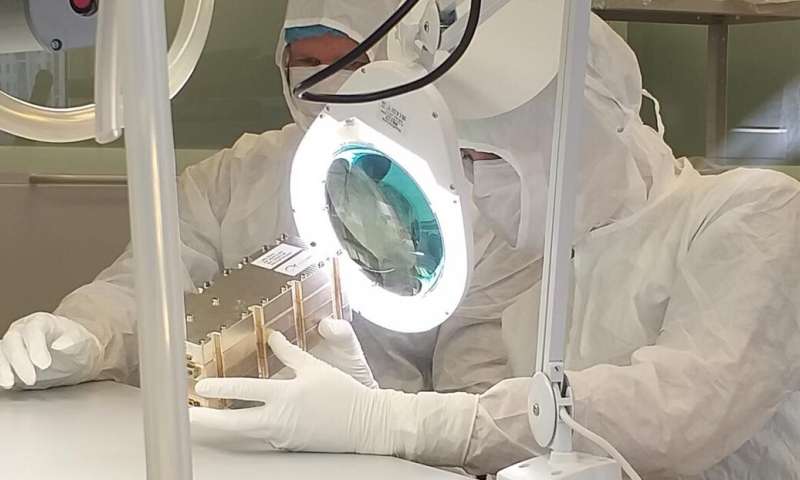
On behalf of the ESA, UCLouvain has developed antennas for the LaRa instrument that will go to Mars in 2020 to study the red planet's habitability. The originality of UCLouvain's concept: the antennas are produced from a single block of aluminium to achieve lightness (132g!), miniaturisation (hand-sized) and great resistance (particularly to day-night temperature variations of more than 200° C). Credit: UCLouvain
Dust storms, ionising cosmic radiation, extreme cold at night ... Mars is not very hospitable! It's for these extreme conditions that the research team of Christophe Craeye, a professor at the UCLouvain Louvain School of Engineering, developed antennas for the 'LaRa' measuring instrument (Lander Radioscience ), which will go to Mars in 2020.
Prof. Craeye's laboratory has been producing antennas for more than 15 years, for various uses: road radars, magnetic resonance imaging, tracking objects equipped with radiofrequency identification (RFID) chips. The goal is always the same: retrieve remotely data sent by a measuring instrument (of a vehicle's speed, the body's internal functions, an object's or individual's location, etc.).
For this expertise, as part of the ExoMars mission, the European Space Agency (ESA) contacted (via Antwerp Space) UCLouvain. The mission's purpose is to study the rotation of Mars in order to learn more about the composition of its core and determine whether the planet was/will someday be habitable. How? By means of the LaRa instrument, which will communicate with Earth via radio waves. Thus the importance of antennas: they receive and emit radio waves. By measuring the Doppler effect—the difference between the frequencies of the waves emitted on the way (Earth-Mars) and those on the return (Mars-Earth)—the antennas will make it possible to better understand the movement of Mars and therefore the composition of its core. This is why LaRa is equipped with 100% UCLouvain-made antennas: a receiving antenna and two transmitting antennas (one of which is a backup).
Production requirements:
- Resilience: Earth's atmosphere protects us from the sun's rays and limits temperature variations between day and night, which makes our planet habitable. Mars doesn't have an atmosphere. Temperatures range from 80° C during the day (when the sun is most intense) to -125° C at night. Not to mention vibrations generated by dust storms.
- Lightweight and miniaturised: the LaRa instrument will be equipped with multiple components, each for a specific use as part of the ExoMars research mission. Its total weight is distributed among its components, which must therefore be the smallest and lightest possible.
The UCLouvain team's greatest feat: from concept to prototype, it created the antenna in a mere three months.
The advantages of UCLouvain's design:
- An innovative manufacturing process: antennas of unprecedented shape were created by milling from a single block of aluminium—no welding means increased resistance to vibration and temperature variations, in addition to being extremely lightweight. The receiving antennas weigh 132g maximum, the emitting antennas 162g maximum. And they fit in the palm of the hand. The design's originality won over the ESA.
- Exceptional sensitivity: the antennas are capable of capturing a radio signal from any direction, and focus it on the transponder's electronics—an area of less than 1 cm² in the centre of the antenna—for the strongest possible signal.
What next? Applications are being developed in the field of satellite communications. And many industrial collaborations exist in fields beyond space and as varied as medical imaging, radio-frequency sensors, radar and telecommunications.
Citation:
132 grams to communicate with Mars (2019, November 6)
retrieved 6 November 2019
from https://phys.org/news/2019-11-grams-mars.html
This document is subject to copyright. Apart from any fair dealing for the purpose of private study or research, no
part may be reproduced without the written permission. The content is provided for information purposes only.
#Space | https://sciencespies.com/space/132-grams-to-communicate-with-mars/
No comments:
Post a Comment